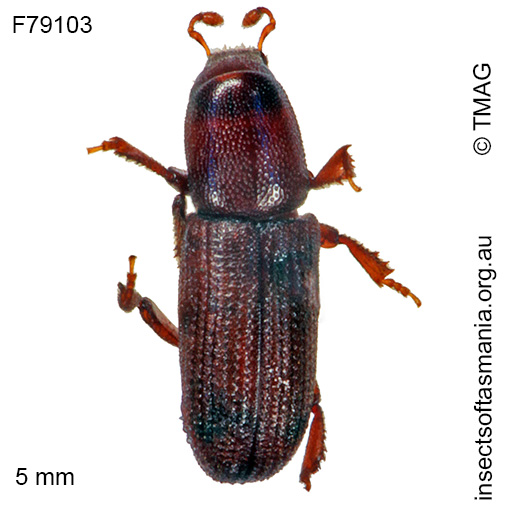
Hylastes ater (Paykull, 1800) (black pine bark-beetle)
Basis for Tasmanian occurrence
TMAG collecctions
Introduced from Europe.
Classification
Order: Coleoptera
Suborder: Polyphaga
Superfamily: Curculionoidea
Family: Curculionidae
Subfamily: Scolytinae
Tribe: Hylastini
Morphology
Typical length (mm): 5
Flightedness: winged and assumed capable of flight
Ecology
Assumed larval feeding: wood-feeder
Association with dead wood or old trees: obligately saproxylic
Ecological attributes: — Can inflict significant damage on Pinus radiata (Elliott & deLittle, 1985) — May occupy logs or trunks of Eucalyptus obliqua, at least temporarily, since found having emerged within six years of felling (Grove et al., 2009).
Collection method(s) for TMAGmaterial: — Baited trapping (funnel trap) — Emergence trapping from log of Eucalyptus obliqua — Hand collection (substrate not specified) — Hand collection from Eucalyptus amygdalina — Hand collection from under bark (tree species not specified) — Malaise trapping — Panel trapping — Pipe trapping — Pitfall trapping — Rearing in insectary from Eucalyptus obliqua — Vane trapping.
Source ecological literature:
Grove, S.J. (2009b). Beetles and fuelwood harvesting: a retrospective study from Tasmania’s southern forests. Tasforests 18: 77-99.
Baker, S.C. (2006b). Ecology and conservation of ground-dwelling beetles in managed wet eucalypt forest: edge and riparian effects. PhD thesis, Univ. of Tasmania, Hobart.
Elliott, H.J. & deLittle, D.W. (1985). Insect pests of trees and timber in Tasmania. Hobart: Tas. Forestry Commission, 90 pages.
Grove, S. et al. (2009). A long-term experimental study of saproxylic beetle … succession in Tasmanian Eucalyptus … logs… In: Fattorini, S. (Ed.), Insect Ecology and Conservation. Research Signpost, pp. 71-114.

